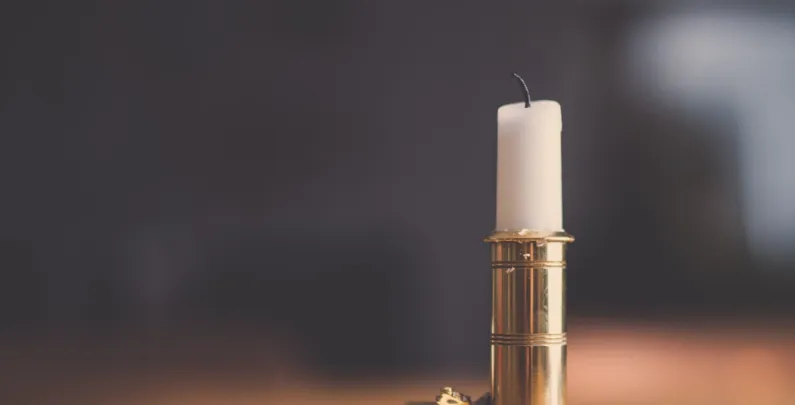Essentially, the candle has not changed much throughout history. It consists of a mass, generally a cylinder or block, of wax or other fuel with an embedded central wick that produces light when burned. Some candles may contain multiple wicks.
The term “wax” applies to a large group of chemically different materials or substances. They are typically composed of hydrocarbons, alcohols, fatty acids, and esters and are generally solid at ambient temperature, insoluble in water but soluble in nonpolar organic solvents, and have a melting point between 110°F to 200°F (approximately 43°C to 93°C).
There are a multitude of formulas and substances available under the name “wax,” and this amount continues to increase as chemists experiment with new chemical compositions. Waxes can be classified into two main groups: natural waxes and synthetic waxes. Natural waxes can further be divided into animal waxes, vegetable waxes, and mineral waxes. Animal waxes include beeswax, tallow, and animal-based stearin. Plant waxes include palm, carnauba, bayberry and soy. Mineral waxes can be further divided into fossil or earth waxes, which include ceresin and montan, and petroleum wax, which includes paraffin and microcrystalline. Synthetic wax consists of man-made materials and includes polymer waxes.
A wick is a strip or thread of fibrous or porous material that draws up the fuel (the wax) to the flame by capillary action. They come in a variety of material and thicknesses, depending on the desired result and the other components of the candle such as the wax type and size, fragrances, and colouring. There are hundred of types of wicks, but common materials include paper, flax, hemp, cotton, wood, and metal-cores such as zinc and lead.
Before going into the manufacturing process or how candles are made, it can be helpful to know how a candle works, or how it burns.
When a candle is lit, the heat from the flame melts the wax in and near the wick. This liquid wax is absorbed by the wick and is pulled upward in what is known as capillary action. Wax needs to be in a gaseous state for it to ignite and burn, and this happens when the wick traps the liquid wax in the heat of the flame, causing it to get hotter and hotter until it turns into gas. This wax vapour acts as fuel to keep the wick burning. The resulting heat travels in all directions.
Heat travels down the wick to melt more wax at the top of the candle. Hot wax vapours are drawn out from the wick and draw oxygen into the base of the flame. The hydrocarbons start to break down into molecules of hydrogen and carbon and then react with oxygen in the surrounding air to produce heat, light, water vapour, and carbon dioxide.
The chemical reaction in which the wax reacts with oxygen in the air is known as combustion, and it produces carbon dioxide and water in the form of steam.
The oxygen-rich base of the candle flame is characterized by a blue colour. The blue zone of the flame is where the oxygen enters and the hydrocarbon molecules begin to vaporize and separate. Surrounding the flame is a faint outside, called the veil, that is also blue because it directly meets with the oxygen of the air. It is also known as the outer zone and is where complete combustion of the wax takes place. This veil is the hottest part of the flame and reaches 1400°C, or 2552°F.
Above the blue zone of the base, directly above the wick, the flame has a dark or orange/brown region which has relatively little oxygen. This section, also known as the dark inner zone, consists of unburnt wax vapours. Soot (small, hardened carbon particles) begins to form as carbon continues to break down. The soot is not harmful if it burns up before leaving the flame. It is these carbon particles that create the dark colour. This zone emits the least heat.
The next zone is the yellow zone, also known as the luminous zone. It consists of partial combustion (insufficient oxygen is available to completely burn all of the wax vapour) and is moderately hot. The carbon particles increase and then rise, where they heat until they ignite. The perceived colour is due to the ignition of the carbon particles. As they are heated, they glow or become “yellow-hot” in what is known as incandescence. They emit the full spectrum of visible light, but it is the yellow portion that is the most dominant.
The process of the wax being heated and then drawn up the wick, where it vaporizes and combines with oxygen in the air to combust, or burn, continues to repeat until all the wax has been burned or the heat has been eliminated. The combustion process may also take a few minutes after the candle has been lighted in order to stabilize.
This combustion process of a candle can be very efficient, but it isn’t perfect. All candles produce soot and smoke due to incomplete combustion. Insufficient oxygen is available to fully combust the soot particles, and some escape. This soot and smoke come from the bright yellow zone of the flame. If sufficient oxygen were available, then there would be no soot. Only carbon dioxide and water would be produced, and the entire flame would be blue.
The exact colour can indicate the temperature, the type of fuel, and the type of combustion taking place. Blue indicates complete combustion, such as in the case of a gas burner, while yellow indicates incomplete combustion, like in a candle flame.
In the next blog post of this series, we will begin to look into the general candle manufacturing process, starting with the preparation of the wick.


Leave a Reply
You must be logged in to post a comment.